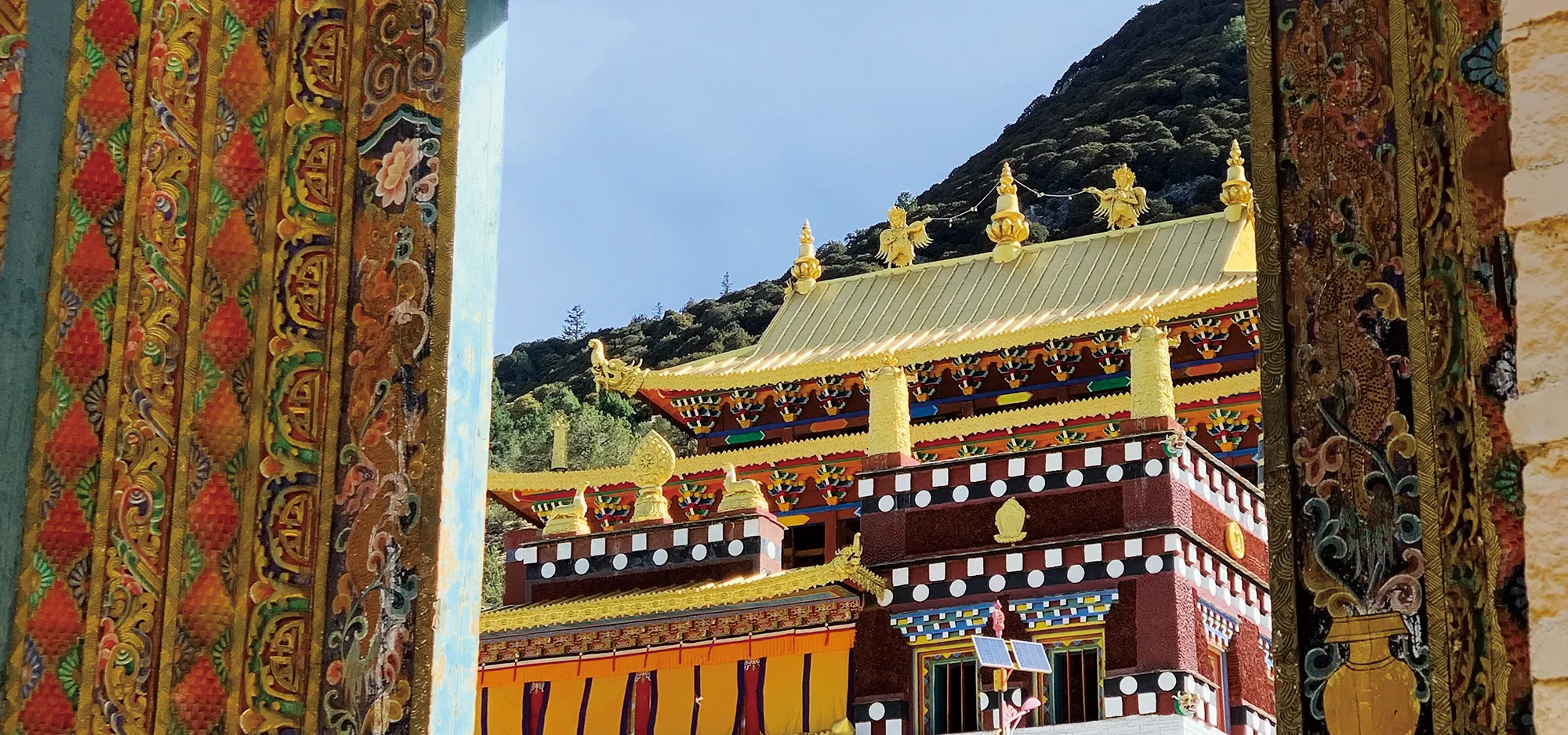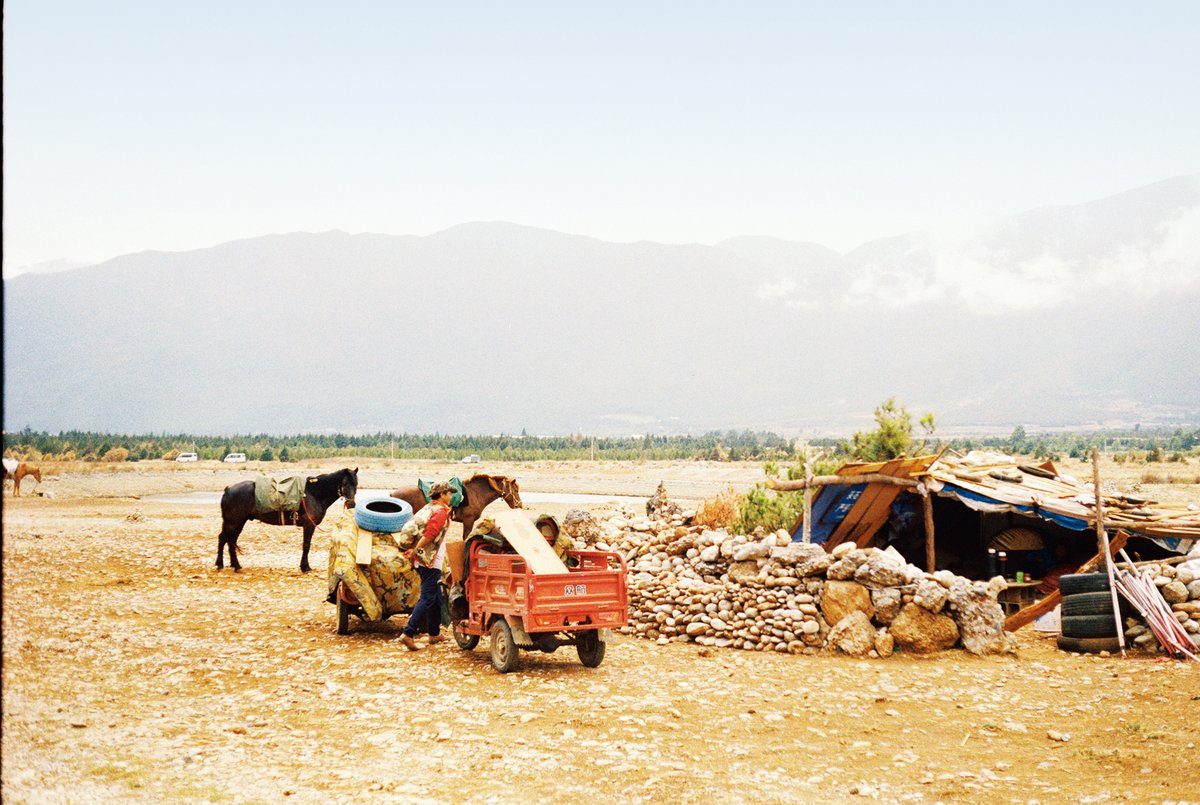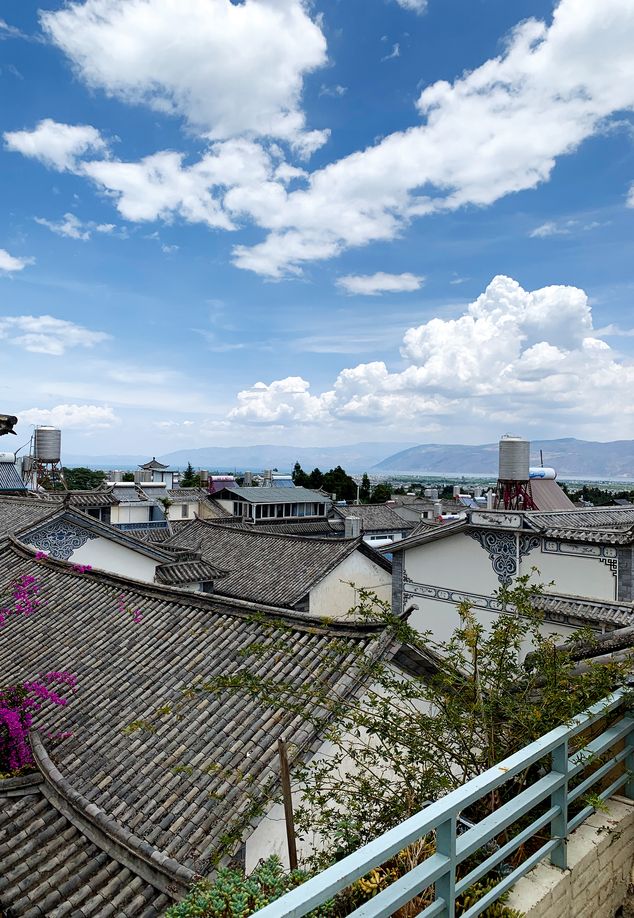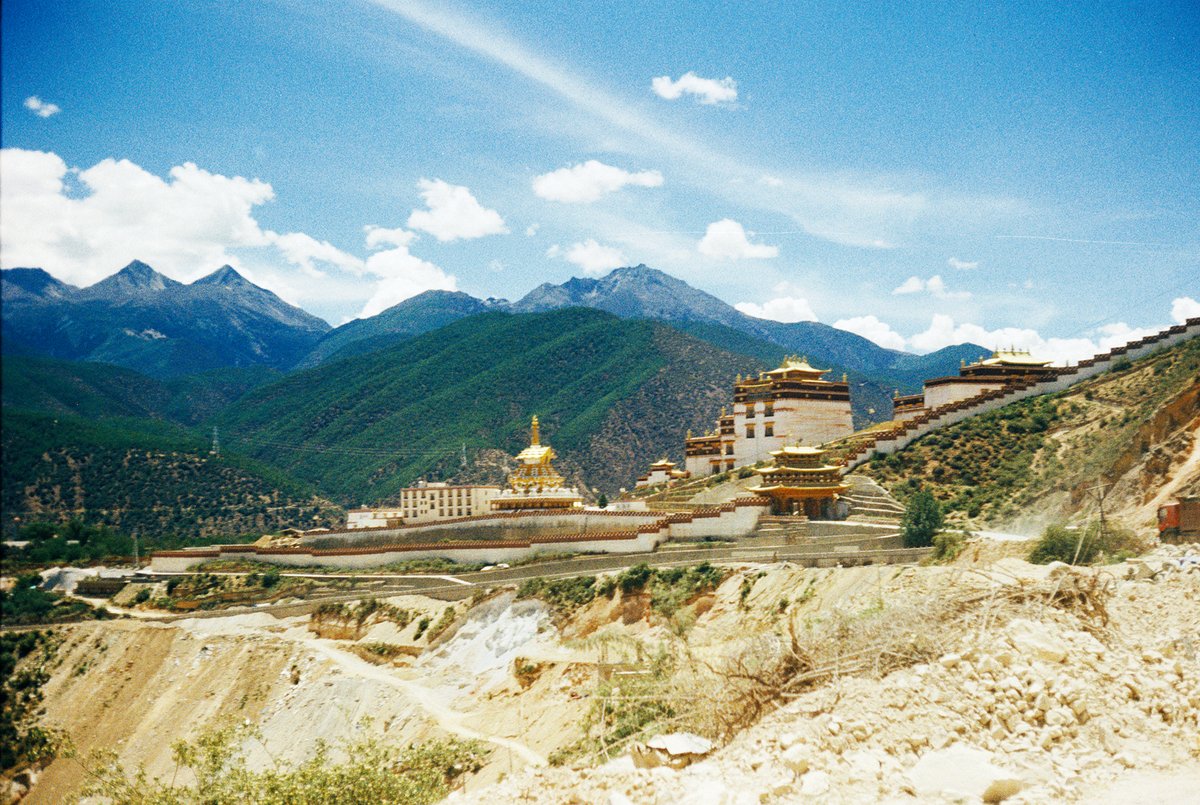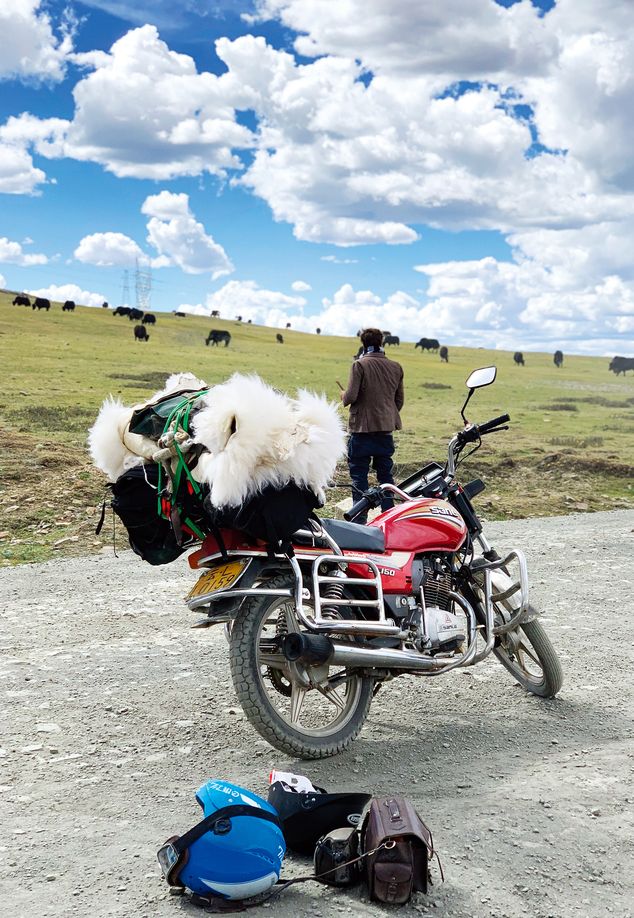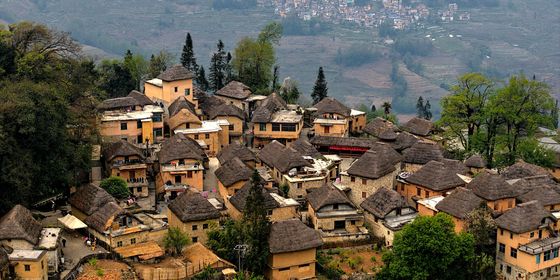A motorbike journey goes behind the scenes of Yunnan’s tourism industry
“Can I get a helmet with this?” I ask the owner in a small courtyard shop in downtown Dali, the picturesque city in China’s southwestern Yunnan province known as a hip backpacker destination. It’s also a gateway for exploring the mountainous borderlands between northern Yunnan and southern Sichuan province, on which I’d agreed to escort a Thailand-based tour operator called Aleks Konge by motorbike, acting as his fixer and interpreter in the summer of 2019.
Potted plants dot the walls of this compound, which is built in the traditional architectural style of the Naxi people in Yunnan. There are also several old motorbikes, including the one that Mr. Konge and I have just taken off the owner’s hands. “Here is one for you,” the owner says, handing me a sky-blue helmet worn by drivers from take-out delivery platform Ele.me. I am not sure what people will make of this on the road, I think to myself, but I put it on anyway.
“You can get this for free,” he says, “just don’t tell anybody where you got this motorbike from.” Secondhand motorcycles are illegal in many parts of the Chinese countryside and obviously this man does not want any of his remaining bikes confiscated.
“And here we are, searching for the perfect route from the magic of Shangri-La, through greater Tibet and over the roof of the world to Chengdu,” Mr. Konge croons, with no-holds-barred drama, as he stares into the black eye of an iPhone camera.
Having operated and planned tours across Asia for over a decade, Mr. Konge, who is originally from Denmark, knows what story to tell Western tourists in order to sell package holidays. He has come to plan a “Tibetan adventure” which he can pitch to travel companies in and outside China, and even though we are technically in Yunnan province, he says that any tour that has the word “Tibet” in it carries a romantic allure that is an easy sell with most Americans and Europeans.
Trips to the Tibet Autonomous Region (TAR) are notoriously costly, due to the expenses related to special permits and mandatory fees for local guides. Finding a way to undercut this, without undercutting the experience, is good business. And the alpine peaks and prayer flags in the background of Mr. Konge’s video will do just fine as content for his travel company’s social media platforms.
Suppliers of the authentic
We drive through the gates of the ancient, walled portion of Dali city, the capital of the Dali Kingdom of the Bai people until the 13th century. Soon, we find a local guesthouse in the city center. From the roof terrace, there is a view of all the slate rooftops of the old city, and far away, at the bottom of the valley, Erhai Lake glistens in the early summer sun.
“Are you delivery drivers?” The staff of the guesthouse ask before they cook lunch for us, eyeing our helmets. Mr. Konge makes his pitch: “I can send you customers directly, if you can find activities for them to do.”
This is the essence of the arrangement: Mr. Konge brings the customers and vouches for the local supplier, in this case the guesthouse.
I ask the local staff what tourists like to do in Dali. “Foreigners love hiking,” one of them says, “and young Chinese come here to relax.” Dali is known for hosting youngsters and “digital nomads” traveling to hostels across China to meet peers and simply hang out, sometimes for entire seasons. In this hostel there is a library, and plenty of space to socialize or relax for guests who just want to escape the rat race of the eastern metropolises.
Outside, a mosaic by the entrance spells out English words: “Feeling. Always. Grateful. Never. Stop.”
Today, the western part of Yunnan is an area that is lending its allure to a booming tourism industry, carefully crafted to cater to both international and domestic tourists. According to provincial government data, Yunnan received more than 529 million visitors in 2020, generating more than 647 billion yuan from tourism alone.
But the stories that sell are often the ones crafted to meet romantic expectations of visitors, and in this region, tourism development often shapes the identity of a city, and even its name.
The rate with which tourism companies set up shop and go under is staggering, according to Mr. Konge, which means that inspecting the operations of suppliers and securing contacts on the ground gives tour operators a huge advantage. That is what Mr. Konge has been doing throughout Southeast Asia—and now he’s setting his sights on China as well.
With one supplier under our belt, we continue north along the road beside Erhai Lake. Between the mountains and the lake, corn and barley fields stretch for miles on each side of the road.
We head toward Lijiang, another major tourism destination in the area that was once the cultural center of the Naxi people. Again, Mr. Konge is working his magic with local suppliers and guesthouses before we venture into the old town.
It is heavily touristed. Most of the inner city is a UNESCO heritage site constructed in the 12th century. It reflects the culture of the Naxi, one of the many ethnic groups living in the foothills of the Himalayas. Naxi architecture can be described as a crossover between Han and Tibetan—with arched roofs supported by heavy wood beams and covered by burned black tiles.
These traditional homes, however, have been taken over by shops that sell food and souvenirs to the Han Chinese tourists arriving en masse from various parts of the country. “Which part of Yunnan are these from?” I ask a shopkeeper, picking up brightly colored scarfs from a rack. “They are from Northeast China,” she answers drily.
On the way toward Tiger Leaping Gorge, a dramatic river valley popular with hikers, we chance upon a tent set up by horse-riding Naxi nomads, who make a living from herding as well as guiding tourists. The road north takes us past three couples in wedding attire having pictures taken with the snow-capped backdrop of the Jade Dragon Snow Mountain, which rises nearly 5,600 meters above sea level. Such arrangements seem popular this time of year, in the early summer, and can be booked in downtown Lijiang at fixed fees, complete with a driver, a photographer, and an assistant crouching with a collapsible light reflector.
As we ascend the mountains, we stop for refreshments. An old man gazes up at one of the peaks. “No one has ever reached the top,” he says. “It is sacred. Untouched.” I have no way of verifying his claim, but I scribble down his dramatic utterance before we continue deeper into the valley.
We are aiming to reach the city of Shangri-La that night, so we press on. I can see the mighty Tiger Leaping Gorge to my left, and Baimai (White Wheat) village to my right. At dusk, we drive down the valley to the Jinsha River in search of a bridge, but we find none—the road leads directly into the heavy currents of the river.
“You gotta take the ferry tomorrow morning,” a guesthouse owner tells us. His place is an old wooden property with multiple floors, and Mr. Konge has already handed over his business card to the owner as soon as we’re off the motorbike.
“This is really authentic,” Mr. Konge exclaims. He tells me that the feeling of authenticity, of being off-the-beaten path—however exoticized—is a must-have in order to effectively market to the modern consumer.
It is selling the feeling of unique experiences in bulk, and at the end of Tiger Leaping Gorge, he has found another supplier to help him do just that.

The ferry crosses the Jinsha River north of Tiger Leaping Gorge, and can only carry a few vehicles as it navigates the currents
The next morning, we drive straight to the river. “It will cost you 15 yuan to cross,” the ferryman says. “Just wait a bit. Let the sheep van get on first.”
A small truck, packed with animals on the back, reverses down a gravel slope, before it drives onto the ferry. “People drown here every year,” the ferryman says, as he commandeers the vessel across the strong river current. His mobile phone number is written above the steering booth, in case he is away on business when prospective customers come across his boat.
Beyond the river, the road winds through pine forests, and climbs further up. Soon, we are 2,000 meters, then 2,500 meters above sea level, zipping through small roadside villages with wooden houses framed by mountains.
Before long, the Naxi villages give way to Tibetan settlements, with square brick houses and fields of Tibetan barley, and the occasional wooden rack for drying the crops of the harvest.
As the sun lowers, we race past stupas that protrude into the sky at intersections, leading toward Shangri-La. With the last beams of the sun on the horizon, we scale the final hill, before we set our eyes on the entire city below.
Seeking Shangri-La
“It was perfectly true; he just rather liked being at Shangri-La. Its atmosphere soothed while its mystery stimulated, and the total sensation was agreeable.”
These are the iconic lines that created the myth of Shangri-La in James Hilton’s 1933 novel Lost Horizon. The city known today by the same name in the northwestern-most part of Yunnan was formerly called Zhongdian in Chinese (Gyalthang in Tibetan) since the Ming dynasty (1368 – 1644), which translates to the unromantic “Middle Field.” It was renamed in 2001 after the fictional utopia in Hilton’s novel, in a naked effort to promote tourism in the area.
Nothing could be better for tourism than the allure of a secluded paradise lost to time, full of ancient wisdom that elsewhere has been subsumed by the logic of the modern, urban, middle-class nuclear family. The renaming strategy seems to have worked, because the area has since attracted tourists from all over the world.
After making his pitch, Mr. Konge finds more “authenticity” here as our hotel’s manager takes him on a tour of the surrounding countryside, where tourists can book treks and sleep in local farmers’ cottages. I find a sheepskin that I purchase for 300 yuan and put over the motorbike.
We drive north until we hit the upper Yangtze River, and arrive in the southwestern corner of Sichuan province.
“Do you have permits?” a young Tibetan man asks me. In order to travel to the TAR, as well as some Tibetan areas in Sichuan, international travelers need to obtain a Tibet Travel Permit. Being on an ad hoc adventure, we have not obtained any of these permits. Even so, we both answer, “Yes, of course!”
We are invited by local Tibetans in a field to partake in dancing in the summer night. We drink yak butter tea and eat bread made from tsampa, Tibetan barley flour, until the dusk settles. Mr. Konge does not take out his business card.
We press on into the night and stop at a roadside inn, where the menu is a surprise to say the least. Besides Tibetan delicacies, it lists the names of several international fast food chains.
“There is no KFC, no Pizza Hut out here,” the young Tibetan waiter explains, “but people still want to eat it, so we put it on the menu. We just make it ourselves.” We order yak steaks and Tibetan fried chicken, and before long we are invited to the next table, where four Tibetan construction workers are dining.
That night, we venture too far into the mountains, and as the fatigue sets in, there are no hotels to turn to. We simply sleep under the stars, on top of a mountain at an altitude of about 4,000 meters. I am shivering in the mountain cold and we huddle together back to back on my recently purchased sheepskin, amid the prayer flags that often mark the top of a mountain pass in Tibetan areas.
The next day, small mountain roads, crisscrossed by yak herders and Tibetan villages, lead us to Litang, a town at the crossroads of major routes that lead west toward Lhasa and east toward Chengdu.
At 3,954 meters above sea level, Litang is one of the highest towns in the world. It has several temples with golden roofs and is surrounded by open grasslands and gleaming white mountains.
After securing local contacts, Mr. Konge leaves for Chengdu. He has a meeting with a supplier there the following day, so we drive to the nearest gas station and ask passing motorists where they are going. Soon, we find a car that can take him to the provincial capital.
I drive back to Litang to pick up my luggage. Just as I drive down a ramp, a cogwheel falls out of the secondhand motorbike and rolls down onto the road. I reverse the bike slowly and crash into a taxi that has materialized into the open space behind me.
Inside the cab, the driver looks at me with a stupefied gaze. Behind him, a Tibetan family sits in silence, waiting to see what will happen. I get off the motorbike to inspect the damage to the car. It’s an old sedan painted yellow and brown, and the rear metaling on the motorbike, where my backpack is fixed onto, has gone clean through the outer hull of the car and left a hole the size of a coin.
I have no idea how this situation will unfold. Over the past ten years, I have driven tens of thousands of kilometers through China and until now, I have luckily been spared any accidents. The taxi driver opens the door and exits the car to inspect the damage, finding the small hole peeking back at him.
“Oh heavens,” he says. “What am I gonna tell the company?” Though Chinese friends and chroniclers of Chinese traffic have all given me the impression that money-for-denting is standard operating procedure on the roads, this will be my first time attempting it, and I have no idea how the driver is going to react. Hopefully, he will not call the police, who may just take the motorbike off the streets.
“If I give you 100 yuan, will it cover the repairs?” I ask the taxi driver. After considering this for a moment, he nods. “Maybe the company won’t even notice it,” he says as he accepts the red bill, laughing.
Apparently, this still works on some roads in China. The taxi driver and the Tibetan family even help me contact a local mechanic, who arrives soon after.
We don’t have anything to drag the motorbike with, except a golden Tibetan prayer flag that I purchased earlier. “That will do,” the young mechanic says, and soon he is hauling my motorbike by the sacred garment through the streets of Litang toward his garage.
After repairing the motorbike I race through the last stretch of my journey toward Chengdu. There are pilgrims and livestreamers on the roads—some are streaming their endeavors on Douyin, the Chinese version of TikTok, or posting content on social media platforms WeChat and Weibo. I meet a traveler who is pushing a cart with all his belongings over the mountains, and another bicycling from Chengdu to the TAR. I also meet a group conducting the ritual of prayer all the way to Lhasa: prostrating themselves to pray after taking every step, their forehead touching the ground. It takes them months to reach their destination.
I wonder again what exactly is “authentic” when there are Tibetan pilgrims livestreaming their holy journeys, or when a town renames itself to attract tourists. Authenticity seems wholly dependent upon the expectations of the visitor.
As Mr. Konge testifies, foreigners romanticize the unchanged countryside, bereft of modernization, while the bulk of Chinese tourists yearn for a stylized and exoticized version of minority areas, all sufficiently picturesque for our social media age. Yet the locals we met on the road seem to be equally content to consume yak butter tea with fried chicken, and to combine Douyin with dancing and prayer.
“The Magic of Shangri-La,” Mr. Konge declares when I meet him in Chengdu. “The tour company accepted my proposal. Now we just have to wait for the guests to book the trip.”
Photography by Mads Vesterager Nielsen
Selling Lost Horizons in Rugged Yunnan Province is a story from our issue, “Public Affairs.” To read the entire issue, become a subscriber and receive the full magazine.





